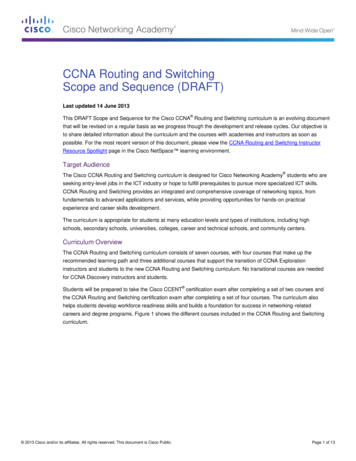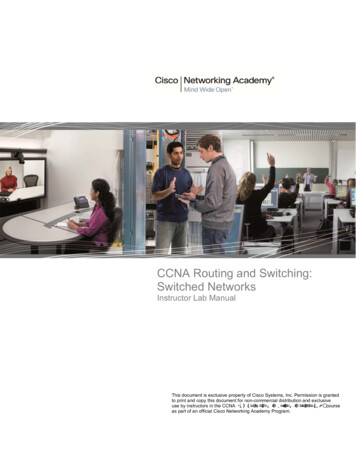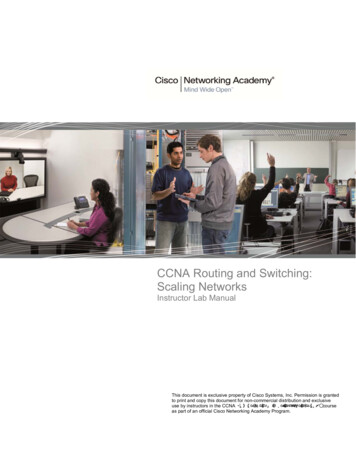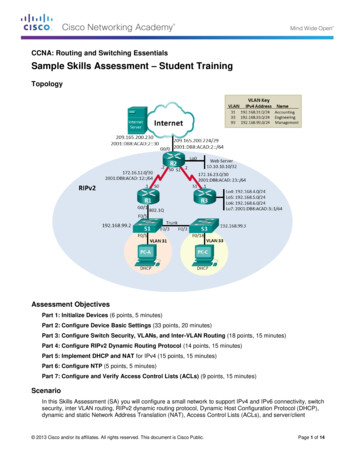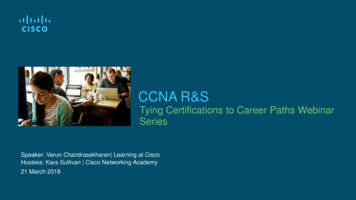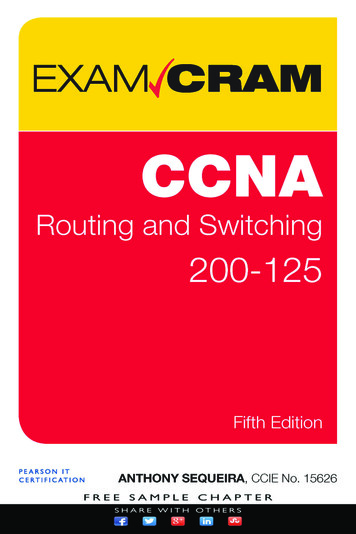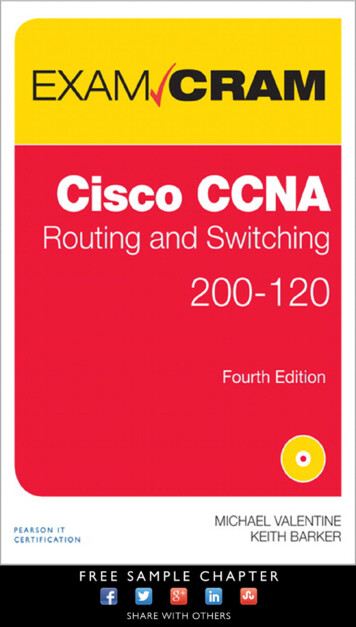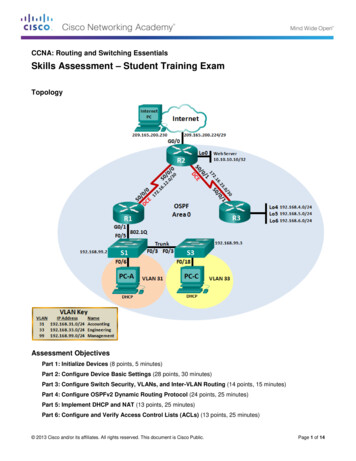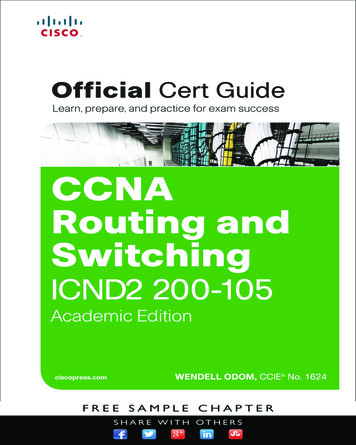
Transcription
CCNA ROUTING &SWITCHINGCurriculum OverviewThe CCNA Routing and Switching curriculum consists of four courses that make up the recommendedlearning path. Students will be prepared to take the Cisco CCENT certification exam after completing aset of two courses and the CCNA Routing and Switching certification exam after completing a set of fourcourses. The curriculum also helps students develop workforce readiness skills and builds a foundationfor success in networking-related careers and degree programs.
Introduction to NetworksThis course introduces the architecture, structure, functions, components, and models of the Internetand other computer networks. The principles and structure of IP addressing and the fundamentals ofEthernet concepts, media, and operations are introduced to provide a foundation for the curriculum. Bythe end of the course, students will be able to build simple LANs, perform basic configurations for routersand switches, and implement IP addressing schemes.Students who complete Introduction to Networks will be able to perform the following functions: Explain network technologies. Explain how devices access local and remote network resources. Implement basic network connectivity between devices. Design an IP addressing scheme to provide network connectivity for a small to medium-sizedbusiness network. Describe router hardware. Explain how switching operates in a small to medium-sized business network. Configure monitoring tools available for small to medium-sized business networks. Configure initial settings on a network device.Chapter1234567891011Introduction to NetworksExplore the NetworkConfigure a Network Operating SystemNetwork Protocols and CommunicationsNetwork AccessEthernetNetwork LayerIP AddressingSubnetting IP NetworksTransport LayerApplication LayerBuild a Small Network
Routing and Switching EssentialsThis course describes the architecture, components, and operations of routers and switches in a smallnetwork. Students learn how to configure a router and a switch for basic functionality. By the end of thiscourse, students will be able to configure and troubleshoot routers and switches and resolve commonissues with virtual LANs and inter-VLAN routing in both IPv4 and IPv6 networks.Students who complete the Routing and Switching Essentials course will be able to perform the followingfunctions: Implement DHCP on a router. Implement network address translation (NAT). Implement access control lists (ACLs) to filter traffic. Determine how a router will forward traffic based on the contents of a routing table. Implement static routing. Explain how switching operates in a small to medium-sized business network. Configure Ethernet switch ports. Implement VLANs. Use monitoring tools and network management protocols to troubleshoot data networks. Configure monitoring tools available for small to medium-sized business networks. Configure initial settings on a network device.Chapter12345678910Routing and Switching EssentialsRouting ConceptsStatic RoutingDynamic RoutingSwitched NetworksSwitch ConfigurationVLANsAccess Control ListsDHCPNAT for IPv4Device Discovery, Management, and Maintenance
Scaling NetworksThis course describes the architecture, components, and operations of routers and switches in larger andmore complex networks. Students learn how to configure routers and switches for advancedfunctionality. By the end of this course, students will be able to configure and troubleshoot routers andswitches and resolve common issues with OSPF, EIGRP, and STP in both IPv4 and IPv6 networks. Studentswill also develop the knowledge and skills needed to implement a WLAN in a small-to-medium network.Students who complete the Scaling Networks course will be able to perform the following functions: Determine how a router will forward traffic based on the contents of a routing table. Implement EIGRP. Implement OSPF. Implement VLANs. Implement enhanced switching technologies and first hop redundancy protocols. Design a small multi-site business network.Chapter12345678910Scaling NetworksLAN DesignScaling VLANsSTPEtherchannel and HSRPDynamic RoutingEIGRPEIGRP Tuning and TroubleshootingSingle-Area OSPFMultiarea OSPFOSPF Tuning and Troubleshooting
Connecting NetworksThis course focuses on the WAN technologies and network services required by converged applications ina complex network. By the end of this course, students will be able to configure PPPoE, GRE, singlehomed eBGP, extended IPv4 and IPv6 ACLs. Students will also develop the knowledge and skills neededto implement a WLAN in a small-to-medium network. For LANs, students will be able to configure SNMPand Cisco SPAN. Students will also develop knowledge about QoS and the trends in networking includingCloud, virtualization, and SDN.Students who complete the Connecting Networks course will be able to perform the following functions: Explain network technologies. Implement access control lists (ACLs) to filter traffic. Configure Ethernet switch ports. Design a small multi-site business network. Select WAN access technologies. Configure a serial interface to enable WAN communication. Configure an Ethernet interface to enable broadband communication given service providerrequirements. Implement remote access and site-to-site VPNs. Use monitoring tools and network management protocols to troubleshoot data networks. Configure monitoring tools available for small to medium-sized business networks. Configure initial settings on a network device. Explain how quality of service (QoS) mechanism support network communication requirements.Chapter12345678Connecting NetworksWAN ConceptsPoint-to-Point ConnectionsBranch ConnectionsAccess Control ListsNetwork Security and MonitoringQuality of ServiceNetwork EvolutionNetwork Troubleshooting
CCNA ROUTING & SWITCHING Curriculum Overview The CCNA Routing and Switching curriculum consists of four courses that make up the recommended learning path. Students will be prepared to take the Cisco CCENT certification exam after completing a set of two courses and the CCNA Routing and Switching
